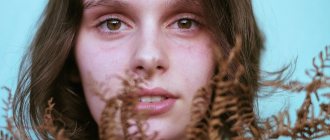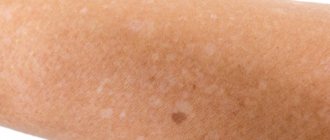Pigment spots are areas of the skin that have darkened for various reasons. They have a brown tint and are noticeably different in color from the surrounding tissues. Unlike skin changes caused by infections, injuries or fungi, age spots never become inflamed, so they are considered a purely cosmetic defect.
At the same time, in addition to deteriorating appearance, age spots cause other problems, often complicated by dryness and roughness of the skin, wrinkles, etc., which is why people try to get rid of them.
Causes of age spots
The color of human skin depends on the concentration of pigments. A lack or excess of melanin, carotene and other pigment substances leads to the formation of pigment spots of different colors and sizes. Discolored patches of skin may be congenital or appear with age. Ultraviolet light often triggers the process - when tanning in the sun or in a solarium. This is because melanin, which gives the brown color, protects the skin from the effects of ultraviolet radiation. The more it gets on the skin, the more melanin is produced.
There are many other reasons why pigment spots form on the face and body. Often this is a consequence of serious disorders in the body. Therefore, if you notice new age spots, you should consult a doctor. The production of pigments is enhanced by:
- Natural and premature aging.
- Hormonal problems associated with thyroid diseases, pituitary tumors.
- Liver diseases.
- Neuropsychiatric disorders.
- Vitamin deficiency, metabolic disorder.
- Gynecological diseases.
Medicines and cosmetics can provoke the problem. Also, age spots are not uncommon during pregnancy.
Do not confuse pigment spots and malignant skin tumors - these are completely different processes. If pigment spots can be left untouched or removed, and in both cases this will not affect general health, then oncological formations require long-term, serious treatment.
Types of pigment spots and methods for their removal
Pigment spots can be small, large, single or multiple. They can have different shapes, usually close to oval, and different colors from light red to dark brown. The most common age spots are freckles, birthmarks and age-related pigmentation.
Freckles. This type of pigmentation is characteristic of fair-skinned people. Freckles usually appear on exposed areas of the body - the face, arms, ears, upper back and chest. Their color changes depending on the intensity of the sun. It is believed that freckles are caused by an uneven distribution of pigment in the skin, so over time, when the body gets stronger and adapts, they fade or disappear completely. For many girls, especially red-haired ones, freckles suit them - they add individuality, but this is not always the case. Too contrasting and extensive pigmentation is a reason for complexes, so they are “taken out”.
There are different ways to remove freckles. Traditional medicine, for example, recommends using parsley juice to whiten the skin. Of course, this method will not work immediately - it will take several months. Cosmetology offers much more effective methods. You can quickly remove freckles using chemical peeling with a base of fruit or lactic acids or laser skin resurfacing.
Birthmarks. Moles (nevi) can form on any part of the body. They have an even shape and a rather dark color. Unlike freckles, the melanin that forms the pigment spot is located in several layers of the skin, so removing a mole is more difficult than freckles. Moles have one peculiarity - they can degenerate into cancer, so large and suspicious formations are recommended to be removed. Birthmarks located in places of contact with the seams of clothing, belts and in areas subject to shaving are also removed. An injured mole is a gateway to infection: it can become inflamed, bleed and become wet.
A direct indication for contacting the clinic is a change in the shape, volume and color of the birthmark. Black and asymmetrical moles, bleeding or flaky spots with cracks are especially dangerous.
Moles without signs of cancer are removed with liquid nitrogen, diathermocoagulation or laser. Laser removal of birthmarks is most preferable, since it does not injure surrounding tissues and does not leave scars. And removing moles with a laser does not hurt at all, which is why many patients choose this particular technique.
Age spots. Unfortunately, these signs of impending old age cannot be prevented. Lentigo, as this type of pigmentation is called, appears in people after 40 years of age. Such age spots are especially noticeable during menopause, when pigmentation is spurred by hormonal changes. Lentigines, like freckles, are localized in places where the skin has been exposed to constant sunlight - on the face, arms, chest and back. Women, noticing such pigmentation, are upset, because they cannot hide the brown spots and they clearly show their age.
Age-related pigmentation can only be removed using cosmetic methods - traditional medicine will not help here. You can try medium or deep chemical peeling or low-impact laser removal. The advantage of the latter method is undeniable - after the procedure, only slight redness remains at the site of the spots, which quickly passes. With deep chemical peeling, the cosmetologist completely removes the top layer of skin, so recovery will take at least a month.
Large pigment spots. Melasma is a significant cosmetic problem. Unlike moles, such age spots have an uneven shape and look very unattractive. Their color intensifies in the sun - in spring and summer, and in winter the pigmentation decreases. Large pigment spots are a sign of hormonal changes, so they often occur during pregnancy, taking hormones, and the onset of menopause.
Large age spots can go away on their own, but women do not want to wait for this moment, so many resort to the help of a cosmetologist. Light peeling, special whitening masks, laser skin resurfacing, etc. can reduce the color of such spots.
Symptoms and causes of skin spots
A change in color in a particular area of the skin may indicate hemorrhages, chronic diseases and infections. Their appearance can also be due to external factors: allergies, burns, prickly heat, diaper rash. The color of the macula is determined by the level of melanin: in brown and black spots there is most of it, in white formations there is no melanin, red spots appear on the body during inflammatory processes. Also, by the appearance of the exanthema, one can assume its nature and cause of origin.
White spots
Content:
- Symptoms and causes of skin spots
- Treatment and diagnosis
Like all other types of rashes, white macules on the body appear suddenly and can cover large areas of the skin. Spots with a white or transparent tint indicate hormonal imbalance, infection or chronic pathologies. In appearance, there are formations that resemble a birthmark, only lighter. Such an exanthema never protrudes above the surface of the skin, does not crust over, or itch. In this case, the cause may be vitiligo, a hereditary disease that is not life-threatening, but also cannot be cured. Similar symptoms occur with leukoderma, a disorder of pigment production. There are syphilitic and false leucoderma. The first is treated with drugs for internal and external use (only under the supervision of a doctor). The false one appears and disappears on its own, and is most often localized on the neck and chest.
A rash in the form of white spots with a rough surface appears with pityriasis versicolor. In this case, the exanthema first looks like white formations, and over time it can turn into the form of red macules. The rashes often flake and itch and appear on any part of the body. Requires treatment, as lichen is easily transmitted through contact. Also, colorless formations with a red rim indicate dry skin, lack of vitamins and minerals. They appear more often on the shoulders, outer thighs, wrists, and under the breasts.
Red spots
Often redness does not threaten the patient; it passes quickly and without a trace. This happens when in contact with nettles or poison ivy, minor burns, or allergies. The most harmless cause of stains is insect bites. They are easy to distinguish from all other types of exanthema, since they are single, itchy and protrude slightly above the surface of the skin. The cause of such spots is easily traced, and no special treatment is required in this case.
In some cases, red spots on the arms, legs, or torso may indicate a more serious problem. Most often, such exanthema appears when:
- Infectious diseases. Scarlet fever, rubella, measles, and chickenpox are characterized by a specific rash. As a rule, in such cases, spots appear simultaneously with an increase in temperature and general malaise. The rash progresses rapidly, covering the face, neck, limbs and torso. The spots in such diseases are small in size and sometimes cover a large area of the body. The rash can transform into blisters or pustules when scratched.
- Allergies are the most common cause of blotchy rashes. Appears on the palms and fingers upon contact with an allergen. Also, if you are allergic to the material, spots can cover the entire body. Food allergies are often characterized by a rash on the neck, face, and chest. Along with exanthema, concomitant symptoms of the disease may appear: sneezing, coughing, lacrimation, runny nose.
- Eczema. Pinkish or red areas appear on the body that are very itchy and painful. Over time, crusts and blisters from itching form in place of the macules. This disease must be diagnosed and treated.
- Depriving. A characteristic feature of lichen is the rash itself: it occupies a separate area of the skin without spreading throughout the body. At the same time, lichen, like other infections, can occur against a background of fever and general malaise.
- Hemangioma is a benign formation. May be pink, red or purple. Localized on the face: at the wings of the nose, on the eyelids, near the ears, near the mouth. This disease can be congenital, but manifests itself at different ages and is usually removed with a laser.
- Psoriasis. A disease in which recurrent exanthema forms; the spots are often covered with a light crust. The rash appears due to stress, alcohol consumption, infections, etc. In the absence of treatment, it can go away on its own, but in conditions of poor hygiene and a low standard of living it progresses.
- Stress. In sensitive people, individual red macules may appear in stressful situations, in moments of anger or fear. More often, this phenomenon occurs in people with disorders of the autonomic nervous system. They do not require special treatment and go away during a period of calm.
- Diaper rash. It is also a safe phenomenon, which is more common in young children on the legs, genitals, buttocks, and armpits. Bright scarlet spots are formed from high temperature and sweating and do not require special treatment. To eliminate the symptoms of formation, you need to treat it with talcum powder and maintain hygiene.
Any of these diseases manifests itself in both adults and children. In pregnant women, rashes in the form of red spots may appear due to hormonal changes. If exanthema appears regularly, you need to consult a dermatologist to accurately determine its cause.
Brown spots
The rash, which appears as brown spots, may be congenital or develop over time. In most cases, they are not dangerous and do not require treatment. They get rid of them mainly because of aesthetics, for example, when brown spots appear on the face. The main reasons for their appearance:
- hormonal imbalance or changes;
- genetics;
- pregnancy;
- very fair skin;
- aging of the body;
- liver diseases;
- melanoma;
- fungi;
- impaired thyroid function.
As you can see, the reason can be completely harmless, or it can be dangerous. Brown spots on the face are called chloasma; they most often appear in pregnant women and go away on their own after childbirth. The same symptom occurs in women who use hormonal contraceptives and in adolescents during puberty.
Lentigo pigment spots form on the chest of women and men, back, shoulders, and rarely on the inside of the thighs. The first manifestations occur in children under 10 years of age, occupy large parts of the body, but do not cause discomfort. Also, such symptoms are observed in older people - senile lentigo.
Brown macules may indicate infection with a fungus. If changes in the skin occur for no apparent reason, do not itch or hurt, and are not covered with hairs, this may indicate a fungal infection. If the microorganism settles in the upper layers of the skin, only exanthema will appear, without other symptoms. If such formations itch, there is a fungus in the deep layers of the dermis. The disease is treated with antifungal drugs and external agents. More often it affects people who shower with gel or soap 2 times a day.
Blue and purple spots
Maculae with a purple, wine or blue tint appear when there are disturbances in the circulatory system. A common occurrence is bruises after blows and contusions; they are formed from minor hemorrhages and blood clotting in certain areas of the body. The same shade occurs in birthmarks, which are extremely dangerous to remove on your own. Bluish spots with smooth edges on the face, chest, arms and legs appear when:
- thrombocytopenic purpura;
- meningococcemia;
- capillarotoxicosis;
- toxic shock syndrome;
- Kaposi's sarcoma;
- rheumatoid arthritis;
- leukemia;
- vitamin deficiency.
Any of these conditions must be treated, so if single macules of a wine or purple hue appear, you should visit a dermatologist. If a dark blue rash appears suddenly, grows and occupies large areas of the skin, seek emergency help immediately. Such symptoms appear in toxic shock syndrome, which is very life-threatening for the patient.
Parents of small children should also not ignore small and large spots with a bluish tint on the child. If macules appear regularly, do not go away, and their nature cannot be traced, it is better to consult a pediatric dermatologist or pediatrician.









